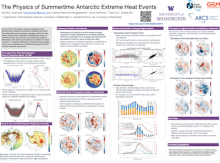The Drivers of Summertime Antarctic Extreme Heat Events
Zachary
Espinosa
University of Washington
Poster
Across much of the globe extreme heat events have become more frequent and intense. Despite their impact on surface ice melt, sea level rise, and coastal ecosystems, Antarctic heatwaves remain understudied. Using daily, historical near-surface air temperature from 17 stations on the Antarctic continent and ECMWF reanalysis, we investigate the evolution and drivers of summertime Antarctic extreme heat events. We find that historical trends in heatwave frequency are spatially inhomogeneous and well explained by trends in mean temperature and wind speed across the continent. We investigate the impact of the Southern Annual Mode on the duration and intensity of atmospheric blocking and heatwaves. Finally, we cluster heatwaves based on elevation, and find that high-elevation extreme heat events are always characterized by atmospheric blocking, extreme moisture flux convergence, longwave radiation forcing, total column warming, and enhanced cloud cover. In contrast, low-elevation, coastal Antarctic heatwaves are driven by either high-pressure ridging and northerly warm air advection (similar to high-elevation events) or down-slope winds and large surface sensible heat fluxes.

Poster file
Espinosa_Zac_blocking_poster.pdf
(3.14 MB)
Meeting homepage
